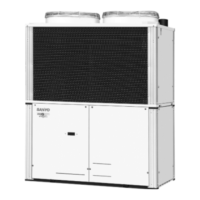Items to Check Before the Test Run
1. Turn the remote power switch on at least 5
hours before the test, in order to energize
the crankcase heater.
2. Turn the outdoor service valves (4 locations)
to the full-open positions.
Use caution when making the settings. If
there are duplicated system addresses,
or if the settings for the Nos. of the indoor
units are not consistent, an alarm will
occur and the system will not start.
These settings are not made on the
indoor unit PCB.
Recheck the items to check before the test run.
YES
Have the outdoor sub units been connected?
NO
Set the unit address.
Set the No. of outdoor units.
Set the No. of indoor units.
Are the inter-unit control wires
connected to more than 1 refrigerant
system?
Set the system address.
When multiple outdoor main units exist, disconnect the terminals extended
from the shorted plugs (CN003) at all outdoor main unit PCBs except for 1.
Alternatively, move the sockets to the OPEN side.
<Outdoor unit control PCB>
Unit No. setting switch
(S004 and S005)
(Check the link wiring.)
<Outdoor unit control PCB>
Unit No. setting switch
(S002 and S003)
NO
YES
YES
NO
NO
YES
CASE 1
CASE 2
Refer to Fig. 7-4
Is it possible to turn ON the power only
for the 1 refrigerant system where the
test run will be performed?
Will automatic address setting be
performed in Heating mode?
CASE 3ACASE 3B
Turn ON the indoor and
outdoor unit power for that
refrigerant system only.
Short-circuit the automatic address pin
(CN100) on the outdoor main unit PCB
for 1 second or longer, then release it.
LED 1 and 2 blink alternately
(about 2 or 3 minutes).
Are LEDs 1 and 2 on the
outdoor unit PCB OFF?
Refer to “Table of
Self-Diagnostic Functions and
Description of Alarm Displays.”
YES
NO
Turn OFF the indoor and
outdoor unit power.
Make necessary corrections.
Check the alarm contents.
*2 A minimum of 5 hours must have passed after the
power was turned ON to the outdoor unit.
*3 All indoor units operate in all refrigerant systems
where the power is ON.
Make necessary
corrections
Turn OFF the indoor
and outdoor unit
Check the alarm
contents.
Is it OK to start the compressors?
Turn ON the indoor and
outdoor unit power.
Short-circuit the mode change pin
(CN101) on the outdoor main unit
PCB. At the same time, short-circuit
the automatic address pin (CN100) for
1 second or longer, then release it.
Start indoor and outdoor unit
cooling operation.
LED 1 and 2 blink alternately.
Start indoor and outdoor unit
heating operation.
LED 1 and 2 blink alternately.
Short-circuit the automatic
address pin (CN100) on the
outdoor main unit PCB for 1
second or longer, then release
it.
Turn ON the indoor and
outdoor unit power.
Is it OK to start the compressors?
*2
*2
3*3*
Are LEDs 1 and 2 on the
outdoor unit PCB OFF?
YES
NO
Check that test run preparation is OK.
(Do not allow the short-circuited pins to remain short-circuited.)
NO
YES
Set the wired remote controller for test run.
Refer to the remote
controller test-run
settings.
Return remote control to normal mode
Check and make corrections according to
“Table of Self-Diagnostic Functions.”
Does system operate?
End test run.
*1 The unit with the unit No. set to 1 is the main unit.
All other units are sub units.
*1
Note:
It is not necessary to remove the
socket that is used to short-circuit
the terminal plugs from the outdoor
sub unit PCBs.
<Outdoor unit control PCB>
Unit No. setting switch
(S006)
<Outdoor unit control PCB>
Unit No. setting switch
(S007)
7-2. Test Run Procedure
Fig. 7-3

